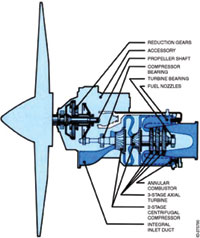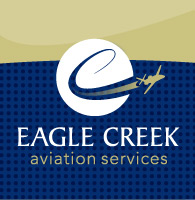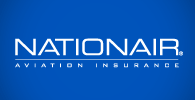TPE331 Power Management
and Operational Features

By Helmuth Eggeling
 The TPE331 engine that powers all turboprop Twin Commanders has been around for decades, but the operating principles that guided its design�simplicity, power, fuel efficiency, and safety�are as relevant today as when the first production engine appeared more than 45 years ago. The following article, which is adapted from Honeywell�s TPE331 Pilot Tips booklet (available online at
The TPE331 engine that powers all turboprop Twin Commanders has been around for decades, but the operating principles that guided its design�simplicity, power, fuel efficiency, and safety�are as relevant today as when the first production engine appeared more than 45 years ago. The following article, which is adapted from Honeywell�s TPE331 Pilot Tips booklet (available online at
https://www.e-engines.honeywell.com/index.jsp; point to �Communications,� then �Pilot Information� then click on �Pilot Tips Book�) takes a look at the TPE331�s power management system and operational features.
Turbine engines achieve their highest efficiency at or near the RPM design point. Therefore, the TPE331 has been designed to operate at a specific RPM, depending on the specific operation.
Power management is that function which maintains a constant speed by controlling the excess of the turbine power (approximately 2/3 of the power produced is used to drive the compressor and 1/3 is excess�useful�turbine power) to equal propeller load.
A hydraulically actuated, constant-speed, full-feathering propeller control system is an integral feature of the engine.
The Propeller Governing System incorporates an NTS System and is interconnected with the Fuel Control System.
Engine Systems
During flight, the Propeller Governing System automatically maintains set engine speed by varying the pitch of the propeller blades in response to changing conditions of flight. Should the system sense a negative torque, the feather valve will operate automatically and bring the prop blades toward feather in order to reduce drag (known as Negative Torque Sensing or NTS).
However, when full feathering is required, the feather valve can be manually activated, causing the prop blades to assume a fully feathered, lowest drag, position.
After landing, manual (Beta) control of the propeller blade angle is available, providing flat pitch (high drag) or reverse thrust to assist in deceleration as well as blade angle control to aid directional control.
Controls (Typical)
 The TPE331 is a pilot�s engine; it is simple to operate and easy to manage. Unlike other engine makes, which require the manipulation of three and even four power management controls (levers), the TPE331 engine has only two: a Power Lever and a Speed Lever.
The TPE331 is a pilot�s engine; it is simple to operate and easy to manage. Unlike other engine makes, which require the manipulation of three and even four power management controls (levers), the TPE331 engine has only two: a Power Lever and a Speed Lever.
The Power Lever of the TPE331 engine is primarily used to control output power. Whether it be fuel or torque depends upon the MODE of operation (TPE331 Training Guide, TSG--134, published 1/1/89, page 2-2).
That is, when advanced forward from the flight idle gate, the Power Lever controls fuel flow, similar to a reciprocating engine throttle. During this mode, the propeller governor automatically maintains set engine speed by varying propeller blade angles in response to changing flight conditions and/or power.
On the ground (only), the Power Lever, when retarded behind the flight idle gate, controls propeller blade angle directly. This mode, power lever range from flight idle to reverse, is called beta mode. During beta mode of operation, the Underspeed Fuel Governor maintains selected engine speed by assuming control over fuel flow.
Warning: In-flight beta mode (Power Lever behind Flight Idle) is prohibited (unless the airplane is certified for in-flight beta mode).
The use of beta mode in-flight is prohibited because placing one or more power levers below the Flight Idle gate sets the corresponding propeller blades at an angle lower than certified for in-flight conditions. Moreover, setting one or more Power Levers below Flight Idle in-flight produces high-drag conditions (resulting in an excessive airspeed deceleration), may induce an uncontrollable roll rate (due to asymmetric thrust and drag), and could block elevator airflow, which would inhibit stall avoidance and recovery.
Refer also to Pilot Advisory Letter: PAL PA331-06, August 5, 1996 for a detailed description of why in-flight beta mode is prohibited.
The Speed Lever, sometimes called the Condition Lever (when linked to the manual feather valve and fuel solenoid manual shut-off lever) or RPM Lever, basically serves one function: to select the engine operating speed. Normal Speed Lever positions are: High, Cruise, and Low. The RPM selected is according to the flight or ground condition, and once set, requires resetting only when the flight condition changes. High (100%) RPM is used for takeoff and landing, Cruise (96-97%) RPM for normal climb/cruise/descent operations, and Low (65-73%) RPM for engine starting and ground or taxi operations.
Instrumentation
Torque is measured as foot-pounds, percent of torque, pounds per square inch (PSI), or as horsepower, depending on the instrument design. Torque indication is representative of power being produced by the engine and is measured on the torsion shaft at the point where power is transmitted to the gearbox. TPE331-5A, -10UG, -11, -12, -14 and --15 engines employ a strain gage torque sensing system, offering improved accuracy and reliability.
Turbine Temperature (EGT/ITT/%) is calibrated in degrees Celsius or as a percentage of maximum and is measured either at the second stage turbine stator (ITT) or in the engine tail pipe (EGT). This instrument represents a compensated value, which correlates to actual TIT (turbine inlet temperature).
Fuel Flow, calibrated in lbs. per hour, is monitored during engine start, used as a crosscheck instrument in flight, and for computing fuel consumption.
The RPM Indicator is calibrated in percent, with 100% ALWAYS USED FOR TAKEOFF AND LANDING. Reduced RPM is typically used for taxi, climb, cruise, and descent, as authorized by the aircraft flight manual.
Oil Pressure and Temperature are normally calibrated in PSI and degrees centigrade respectively.
When compared with reciprocating engines, the operators of the TPE331 enjoy an important cost-effectiveness in that lower-cost jet fuels can be used. In addition, the time between overhaul (TBO) potential exceeds the reciprocating engine by a wide margin, and the cost per mile is favorable due to increased airspeed and higher operating altitude.
Simplified Single-Engine Procedures
 The Negative Torque Sensing (NTS) System provides automatic propeller drag reduction by driving the propeller blade angle toward feather in case of fuel or air starvation or an in-flight engine shutdown.
The Negative Torque Sensing (NTS) System provides automatic propeller drag reduction by driving the propeller blade angle toward feather in case of fuel or air starvation or an in-flight engine shutdown.
Drag is reduced and the pilot has more time to assess and control the situation. Full feather can be selected when desired. Air starts are just as simple. The propeller is unfeathered and the engine restarted as engine speed is increased with the windmilling propeller. No in-flight engine starter cranking is required, and only a few amps are necessary to operate the unfeathering.
Variable RPM Cruise
Selective engine speeds provide extended cruise range at decreased fuel flow and noise levels.
For additional information concerning TPE331 design and operation, please contact me at 602 231-2697, or send an e-mail message to [email protected].
Discuss this article in the forums...







